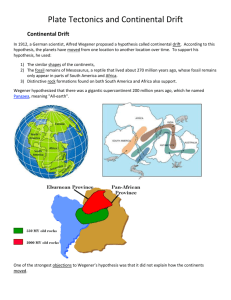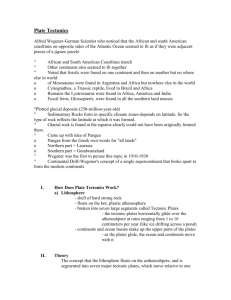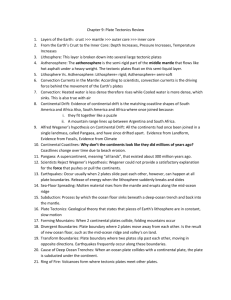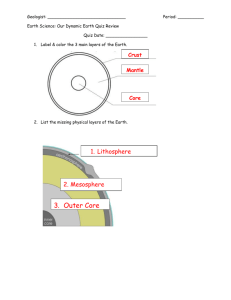9.1_9.2_fullnotes
advertisement
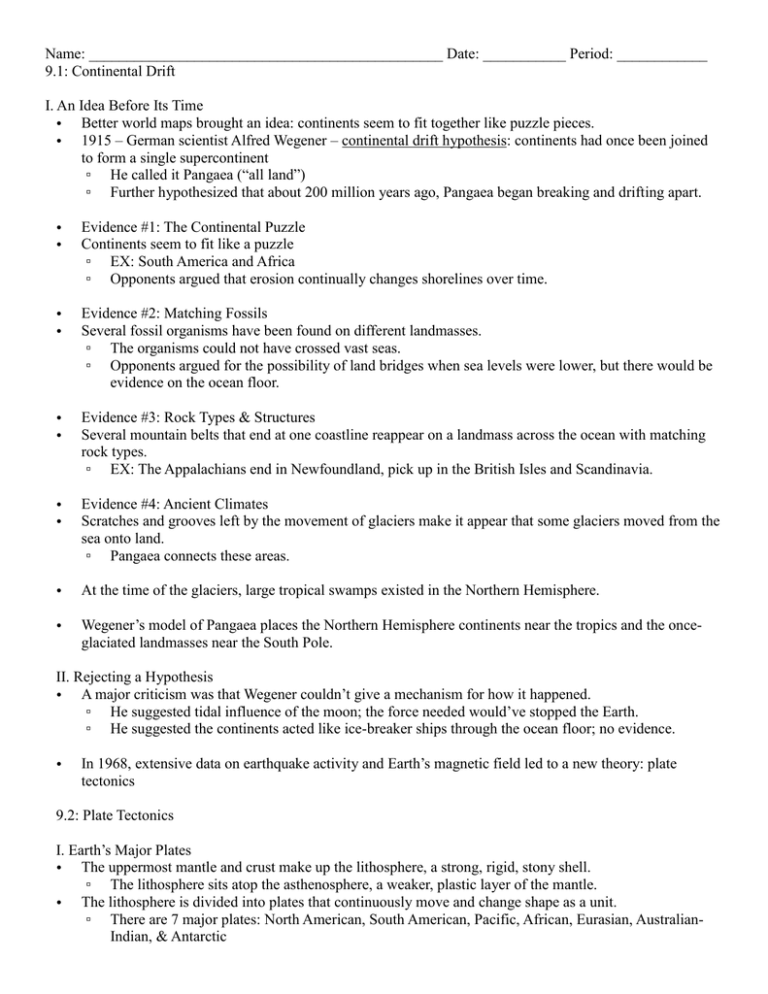
Name: _______________________________________________ Date: ___________ Period: ____________ 9.1: Continental Drift I. An Idea Before Its Time • Better world maps brought an idea: continents seem to fit together like puzzle pieces. • 1915 – German scientist Alfred Wegener – continental drift hypothesis: continents had once been joined to form a single supercontinent ▫ He called it Pangaea (“all land”) ▫ Further hypothesized that about 200 million years ago, Pangaea began breaking and drifting apart. • • Evidence #1: The Continental Puzzle Continents seem to fit like a puzzle ▫ EX: South America and Africa ▫ Opponents argued that erosion continually changes shorelines over time. • • Evidence #2: Matching Fossils Several fossil organisms have been found on different landmasses. ▫ The organisms could not have crossed vast seas. ▫ Opponents argued for the possibility of land bridges when sea levels were lower, but there would be evidence on the ocean floor. • • Evidence #3: Rock Types & Structures Several mountain belts that end at one coastline reappear on a landmass across the ocean with matching rock types. ▫ EX: The Appalachians end in Newfoundland, pick up in the British Isles and Scandinavia. • • Evidence #4: Ancient Climates Scratches and grooves left by the movement of glaciers make it appear that some glaciers moved from the sea onto land. ▫ Pangaea connects these areas. • At the time of the glaciers, large tropical swamps existed in the Northern Hemisphere. • Wegener’s model of Pangaea places the Northern Hemisphere continents near the tropics and the onceglaciated landmasses near the South Pole. II. Rejecting a Hypothesis • A major criticism was that Wegener couldn’t give a mechanism for how it happened. ▫ He suggested tidal influence of the moon; the force needed would’ve stopped the Earth. ▫ He suggested the continents acted like ice-breaker ships through the ocean floor; no evidence. • In 1968, extensive data on earthquake activity and Earth’s magnetic field led to a new theory: plate tectonics 9.2: Plate Tectonics I. Earth’s Major Plates • The uppermost mantle and crust make up the lithosphere, a strong, rigid, stony shell. ▫ The lithosphere sits atop the asthenosphere, a weaker, plastic layer of the mantle. • The lithosphere is divided into plates that continuously move and change shape as a unit. ▫ There are 7 major plates: North American, South American, Pacific, African, Eurasian, AustralianIndian, & Antarctic ▫ There are 6 intermediate plates: Caribbean, Nazca, Phillipine, Arabian, Cocos, & Scotia ▫ ▫ Several of the plates include a continent and a large area of seafloor. Lithospheric plates move about 5 cm per year; this is driven by the unequal distribution of heat within the Earth (creates convection currents). Movement of lithospheric plates generates earthquakes, creates volcanoes, and deforms large masses of rock into mountains. II. Types of Plate Boundaries • Divergent Boundaries ▫ Two plates move apart ▫ Comes from upwelling of material from the mantle, usually to create new seafloor ▫ Usually called “rift valleys” • ▫ ▫ Convergent Boundaries Two plates move together Oceanic lithosphere goes under continental OR two continental plates collide and eventually merge ▫ Transform Fault Boundaries Two plates grind past each other without making or destroying lithosphere EX: San Andreas Fault • • Total surface area of Earth doesn’t change because plate shrinkage equals plate growth. ▫ Antarctic plate is getting larger; Philippine plate is shrinking


